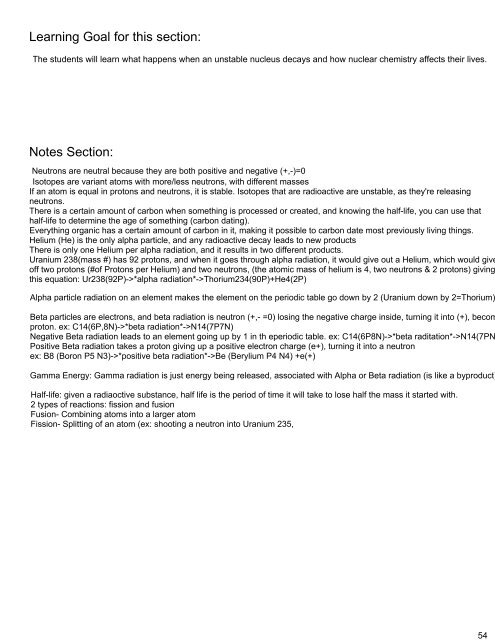Create successful ePaper yourself
Turn your PDF publications into a flip-book with our unique Google optimized e-Paper software.
54<br />
Learning Goal for this section:<br />
The students will learn what happens when an unstable nucleus decays and how nuclear chemistry affects their lives.<br />
Notes Section:<br />
Neutrons are neutral because they are both positive and negative (+,-)=0<br />
Isotopes are variant atoms with more/less neutrons, with different masses<br />
If an atom is equal in protons and neutrons, it is stable. Isotopes that are radioactive are unstable, as they're releasing<br />
neutrons.<br />
There is a certain amount of carbon when something is processed or created, and knowing the half-life, you can use that<br />
half-life to determine the age of something (carbon dating).<br />
Everything organic has a certain amount of carbon in it, making it possible to carbon date most previously living things.<br />
Helium (He) is the only alpha particle, and any radioactive decay leads to new products<br />
There is only one Helium per alpha radiation, and it results in two different products.<br />
Uranium 238(mass #) has 92 protons, and when it goes through alpha radiation, it would give out a Helium, which would give<br />
off two protons (#of Protons per Helium) and two neutrons, (the atomic mass of helium is 4, two neutrons & 2 protons) giving<br />
this equation: Ur238(92P)->*alpha radiation*->Thorium234(90P)+He4(2P)<br />
Alpha particle radiation on an element makes the element on the periodic table go down by 2 (Uranium down by 2=Thorium)<br />
Beta particles are electrons, and beta radiation is neutron (+,- =0) losing the negative charge inside, turning it into (+), becom<br />
proton. ex: C14(6P,8N)->*beta radiation*->N14(7P7N)<br />
Negative Beta radiation leads to an element going up by 1 in th eperiodic table. ex: C14(6P8N)->*beta raditation*->N14(7PN<br />
Positive Beta radiation takes a proton giving up a positive electron charge (e+), turning it into a neutron<br />
ex: B8 (Boron P5 N3)->*positive beta radiation*->Be (Berylium P4 N4) +e(+)<br />
Gamma Energy: Gamma radiation is just energy being released, associated with Alpha or Beta radiation (is like a byproduct)<br />
Half-life: given a radiaoctive substance, half life is the period of time it will take to lose half the mass it started with.<br />
2 types of reactions: fission and fusion<br />
Fusion- Combining atoms into a larger atom<br />
Fission- Splitting of an atom (ex: shooting a neutron into Uranium 235,





